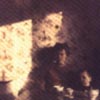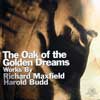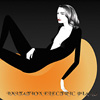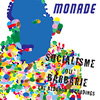 The first time I heard Continental OP, the collaborative projectbetween Dave Pajo and Will Oldham, was on the label Temporary ResidenceLimited's compilation called "Sounds For The GeographicallyChallenged." I bought that record largely because of Continental OP'sappearance on it (I had been tipped off who the band members were) and,after listening to the playful but underwhelming song, regarded theproject mostly as a lark, never expecting to see the collaborativeeffort turn up again. But five years later, team Pajoldham havesurprised me by offering a collection of songs which serve as thescore/soundtrack for an independent short film called "Slitch." Onceagain, the project seems like a lark, as if the two were doing thefilmmaker Dianne Bellino a nice favor, producing a little chestnut:nothing as fancy or remarkable as the Dashiell Hammett character theband's name references. There are springy melodic tracks ("Faster"),Misfits punk rock approximations ("James Tired"), and simplistic songswith second-grade-music-class-instrument accoutrements ("Glock"). Themost resonant song is "La La La," an infectious Free Design inspiredharmony line which I found myself humming throughout the day. All ofthese sort of limp ahead clumsily with no signature sound contributedby either Pajo or Oldham and without any real direction, which bringsus to the film itself. On the flip side of the DVD is Dianne Bellino'sshort film "Slitch." The word "slitch" is an amalgam of "slut" and"bitch," and it is the appellation which the protagonist's bitter oldersisters assign to her because she is distracted in her behavior, aloofin her interactions, and (according to the sisters) often carefreeabout her sexual encounters. At our first glimpse of Slitch, she islying in the grass of some wooded parkland, having ostensibly justslept with the man next to her. She arises with a noticeable glint inher eyes, retrieves her underwear from the shrubbery, and is off. Thefocal point of the film is Slitch's interactions with the local surferdude, played fondly by Will Oldham. Oldham's surfer is as oblivious toSlitch's sexual advancements as she is heavy-handed in their delivery.He just wants to watch surfing videos and surf, while she just wants tohave sex. At one point they compromise and have ice cream. Besidesobserving Oldham, which is always fun, I was delightfully distractedfrom the film by trying to determine if the beach where Bellino filmedwas the same Rhode Island beach where I had spent a Fourth of July onceand a pal of mine had lost his car keys in the sand (they were latermiraculously found in a last ditch effort, but not before I had lenthim $40 to have a new key made. We are both still uncertain if that $40was ever recouped by me). Formally, the film is carefully shot andconsidered. It even has moments of looking delicate, such as Slitch'ssunsetted stroll on the beach or Slitch's silent mom grabbing a MillerHi-Life from the refrigerator, but nothing very engaging in terms ofstory or plot. The film's story is an innocuous Cinderella tale with nosense of danger or drama. Slitch's two evil sisters seem no moreoppressive than a gaggle of noisy geese, and her Prince Charming wouldrather jet off to Hawaii than bother deciphering Slitch's confusingmind state. We are asked to believe that Slitch has an alarming needfor sex, but we never really see this. She does not habituallymasturbate; there are no erotic posters of Corey Haim on her walls; andshe seems able to occupy herself with placid walks on the beach at duskwhile listening to her walkman. Sex seems almost as a healthy avocationto her, not a destructive obsession. The evil sisters ought to relaxtheir criticism of Slitch and take a moment between moustache waxes tograb a beer with mom.
The first time I heard Continental OP, the collaborative projectbetween Dave Pajo and Will Oldham, was on the label Temporary ResidenceLimited's compilation called "Sounds For The GeographicallyChallenged." I bought that record largely because of Continental OP'sappearance on it (I had been tipped off who the band members were) and,after listening to the playful but underwhelming song, regarded theproject mostly as a lark, never expecting to see the collaborativeeffort turn up again. But five years later, team Pajoldham havesurprised me by offering a collection of songs which serve as thescore/soundtrack for an independent short film called "Slitch." Onceagain, the project seems like a lark, as if the two were doing thefilmmaker Dianne Bellino a nice favor, producing a little chestnut:nothing as fancy or remarkable as the Dashiell Hammett character theband's name references. There are springy melodic tracks ("Faster"),Misfits punk rock approximations ("James Tired"), and simplistic songswith second-grade-music-class-instrument accoutrements ("Glock"). Themost resonant song is "La La La," an infectious Free Design inspiredharmony line which I found myself humming throughout the day. All ofthese sort of limp ahead clumsily with no signature sound contributedby either Pajo or Oldham and without any real direction, which bringsus to the film itself. On the flip side of the DVD is Dianne Bellino'sshort film "Slitch." The word "slitch" is an amalgam of "slut" and"bitch," and it is the appellation which the protagonist's bitter oldersisters assign to her because she is distracted in her behavior, aloofin her interactions, and (according to the sisters) often carefreeabout her sexual encounters. At our first glimpse of Slitch, she islying in the grass of some wooded parkland, having ostensibly justslept with the man next to her. She arises with a noticeable glint inher eyes, retrieves her underwear from the shrubbery, and is off. Thefocal point of the film is Slitch's interactions with the local surferdude, played fondly by Will Oldham. Oldham's surfer is as oblivious toSlitch's sexual advancements as she is heavy-handed in their delivery.He just wants to watch surfing videos and surf, while she just wants tohave sex. At one point they compromise and have ice cream. Besidesobserving Oldham, which is always fun, I was delightfully distractedfrom the film by trying to determine if the beach where Bellino filmedwas the same Rhode Island beach where I had spent a Fourth of July onceand a pal of mine had lost his car keys in the sand (they were latermiraculously found in a last ditch effort, but not before I had lenthim $40 to have a new key made. We are both still uncertain if that $40was ever recouped by me). Formally, the film is carefully shot andconsidered. It even has moments of looking delicate, such as Slitch'ssunsetted stroll on the beach or Slitch's silent mom grabbing a MillerHi-Life from the refrigerator, but nothing very engaging in terms ofstory or plot. The film's story is an innocuous Cinderella tale with nosense of danger or drama. Slitch's two evil sisters seem no moreoppressive than a gaggle of noisy geese, and her Prince Charming wouldrather jet off to Hawaii than bother deciphering Slitch's confusingmind state. We are asked to believe that Slitch has an alarming needfor sex, but we never really see this. She does not habituallymasturbate; there are no erotic posters of Corey Haim on her walls; andshe seems able to occupy herself with placid walks on the beach at duskwhile listening to her walkman. Sex seems almost as a healthy avocationto her, not a destructive obsession. The evil sisters ought to relaxtheir criticism of Slitch and take a moment between moustache waxes tograb a beer with mom.
Give us an hour, we'll give you music to remember. This week we bring you an episode with brand new music from Softcult, Jim Rafferty, karen vogt, Ex-Easter Island Head, Jon Collin, James Devane, Garth Erasmus, Gary Wilson, and K. Freund, plus some music from the archives from Goldblum, Rachel Goswell, Roy Montgomery. Rubber ducks and a live duck photo from Matthew in the UK. Get involved: subscribe, review, rate, share with your friends, send images! |



 With the undeniable hit that the Kings of Convenience Remixesalbum became, it's unsurprising that the next move from singer ErlendØye was to continue on the electronic music path, employing theservices of many, leaving the acoustic guitar tunesmith days to liedormant. Unrest features ten songs, each with a differentelectronic music collaborator, each taking place in a different city.The concept is appealing for those who found some of thereconstructions and reworkings a spectacular accomplishment, as theinfluences of outside collaborators and remixers had a marvelouseffect. Without the tinkling guitars and folky vocals serving the basisfor the tunes, the truly unique identity is somewhat lost. While thesongs are somewhat catchy, like the fast-talking (almost rapping)"Prego Amore" with Jolly Music, the opener "Ghost Trains" with MorganGeist of New York and the discoey beats of "Sudden Rush" with Kompis,this album could honestly be another drop in the bucket in the trend ofnew techno pop, popularized by Morr related artists, The PostalService, and others. The most exciting direction unsurprisingly comesfrom Prefuse 73, who has integrated a number of horn, vibe, and guitarsounds into the mix, but only ever subtly and not tampering with theelectronic bass sound that drives the rest of the music. For the restof the record, it's a lot of tired drum machine sounds, sparseinstrumentation, and unchallenging vocals.
With the undeniable hit that the Kings of Convenience Remixesalbum became, it's unsurprising that the next move from singer ErlendØye was to continue on the electronic music path, employing theservices of many, leaving the acoustic guitar tunesmith days to liedormant. Unrest features ten songs, each with a differentelectronic music collaborator, each taking place in a different city.The concept is appealing for those who found some of thereconstructions and reworkings a spectacular accomplishment, as theinfluences of outside collaborators and remixers had a marvelouseffect. Without the tinkling guitars and folky vocals serving the basisfor the tunes, the truly unique identity is somewhat lost. While thesongs are somewhat catchy, like the fast-talking (almost rapping)"Prego Amore" with Jolly Music, the opener "Ghost Trains" with MorganGeist of New York and the discoey beats of "Sudden Rush" with Kompis,this album could honestly be another drop in the bucket in the trend ofnew techno pop, popularized by Morr related artists, The PostalService, and others. The most exciting direction unsurprisingly comesfrom Prefuse 73, who has integrated a number of horn, vibe, and guitarsounds into the mix, but only ever subtly and not tampering with theelectronic bass sound that drives the rest of the music. For the restof the record, it's a lot of tired drum machine sounds, sparseinstrumentation, and unchallenging vocals. Via Tania is the project of ex-Spdfgh bassist/vocalist and Australian nativeTania Bowers in a very relaxed, groove-oriented setting as asinger/songwriter. Those familiar with the musical happenings in the Chicagoscene over the last few years may recognize her from adding guest vocals ondiscs by various artists. On her six-song debut solo EP, engineered by acesoundman Casey Rice (Designer), Dream Of... brings in some very coolinstrumental backing from Tortoise/Isotope 217 members John Herndon on drumsand Jeff Parker on guitar, and also enlists Scott Herren (Prefuse 73, Savath+ Savalas) and While to provide a couple of remixes. The three minute, verylaid back "Little China" showcases Bowers beautiful voice, which arrives attimes very delicately, over solid bass, soft drums, and full, jazzy guitarchords. "Fighter" opens with a series of distant guitar overdubs which statethe chord progressions and melody, only to gradually fade out and introduceupright bass and brushed drums and sultry vocals which carry the tune."Mosquito Lights" is a haunting ballad comprised of dark, thick and minorsounding piano chord progressions and multi-tracked vocals which appear tosing of loss. The breathy vocals and overall vibe of the track "UniverseCity" come through twice on the EP; the second time as a remix by While.This version, the longest track on the disc at just under six minutes, isanchored by a very low-end sliding synth bass line, mechanical percussionand sampled woodwinds which give it a real heavy chill-out vibe. Running atjust over twenty-five minutes, this EP makes for a great introduction forBowers' blend of laid back pop, her full-length disc Under A DifferentSky and also as an artist to watch for.
Via Tania is the project of ex-Spdfgh bassist/vocalist and Australian nativeTania Bowers in a very relaxed, groove-oriented setting as asinger/songwriter. Those familiar with the musical happenings in the Chicagoscene over the last few years may recognize her from adding guest vocals ondiscs by various artists. On her six-song debut solo EP, engineered by acesoundman Casey Rice (Designer), Dream Of... brings in some very coolinstrumental backing from Tortoise/Isotope 217 members John Herndon on drumsand Jeff Parker on guitar, and also enlists Scott Herren (Prefuse 73, Savath+ Savalas) and While to provide a couple of remixes. The three minute, verylaid back "Little China" showcases Bowers beautiful voice, which arrives attimes very delicately, over solid bass, soft drums, and full, jazzy guitarchords. "Fighter" opens with a series of distant guitar overdubs which statethe chord progressions and melody, only to gradually fade out and introduceupright bass and brushed drums and sultry vocals which carry the tune."Mosquito Lights" is a haunting ballad comprised of dark, thick and minorsounding piano chord progressions and multi-tracked vocals which appear tosing of loss. The breathy vocals and overall vibe of the track "UniverseCity" come through twice on the EP; the second time as a remix by While.This version, the longest track on the disc at just under six minutes, isanchored by a very low-end sliding synth bass line, mechanical percussionand sampled woodwinds which give it a real heavy chill-out vibe. Running atjust over twenty-five minutes, this EP makes for a great introduction forBowers' blend of laid back pop, her full-length disc Under A DifferentSky and also as an artist to watch for. Like many current serious artists, Hajsch—who's work lies somewherebetween experimental electronic, electro-acoustic and musicconcrete—tries to break free from categorization. This remasteredreissue of two limited vinyl only albums originally released in 1992 (Nagual and PFN - Hajsch and collaborators)on his own Quiet Artworks label sound both contemporary andchallenging, thirteen years later. "Akasa" is a quiet but intenseopener: a 16 minute journey starting off with concrete sounds,synthesizers and field recordings which build up an electrifyingatmosphere slowly that finally reaches it's peak when an almostorchestral ensemble of viola, cello and clarinet appears. "Nagual (Part1)" takes use of sharp contrasts, with sparkling water morning birds,bound in a nearly dream-like atmosphere. Parts one and two consistmainly of sounds taken from a bicycle, melodica, and a hardlyrecognizable guitar. In "Nagual (Part 2)" the mood changes to a moreunsettling ambience. For those who've read Carlos Castaneda,this shouldn't be unexpected, as the concept of Nagual stands contraryto Tonal, that represents all our known territory, material andimmaterial. "Nagual (Part 3)" is an otherworldly, nearly harmonic shortappendix created only with synth and samples. "Für Cleo" is a pleasantcinema-like closer where a quiet guitar drone meets a melancholicsaxophone. Hajsch's music requests close attention and throws thelistener in an aural environmentof great clarity. His strength lies with the careful arrangement ofseldom heard sounds in the purposeful use of volume and timing. Thefact that these recordings are over 10 years old doesn't matter much,as 1992is stimulating, serious, and strong evidence that some music can betimeless no matter how styles and technical possibilities change.
Like many current serious artists, Hajsch—who's work lies somewherebetween experimental electronic, electro-acoustic and musicconcrete—tries to break free from categorization. This remasteredreissue of two limited vinyl only albums originally released in 1992 (Nagual and PFN - Hajsch and collaborators)on his own Quiet Artworks label sound both contemporary andchallenging, thirteen years later. "Akasa" is a quiet but intenseopener: a 16 minute journey starting off with concrete sounds,synthesizers and field recordings which build up an electrifyingatmosphere slowly that finally reaches it's peak when an almostorchestral ensemble of viola, cello and clarinet appears. "Nagual (Part1)" takes use of sharp contrasts, with sparkling water morning birds,bound in a nearly dream-like atmosphere. Parts one and two consistmainly of sounds taken from a bicycle, melodica, and a hardlyrecognizable guitar. In "Nagual (Part 2)" the mood changes to a moreunsettling ambience. For those who've read Carlos Castaneda,this shouldn't be unexpected, as the concept of Nagual stands contraryto Tonal, that represents all our known territory, material andimmaterial. "Nagual (Part 3)" is an otherworldly, nearly harmonic shortappendix created only with synth and samples. "Für Cleo" is a pleasantcinema-like closer where a quiet guitar drone meets a melancholicsaxophone. Hajsch's music requests close attention and throws thelistener in an aural environmentof great clarity. His strength lies with the careful arrangement ofseldom heard sounds in the purposeful use of volume and timing. Thefact that these recordings are over 10 years old doesn't matter much,as 1992is stimulating, serious, and strong evidence that some music can betimeless no matter how styles and technical possibilities change.  Coming from the school of two guitars, bass and drums, I like to think thatmy interest over the years for certain areas of experimental,electronic-based music has not only lead to a slightly better understandingof the genre but to also recognize and appreciate its more salient artisticqualities. As Antimatter, San Francisco-based sound artist and audioengineer, Xopher Davidson, has recently released a solo disc that plays outlike an aural sojourn to the gallery exhibit of cutting edge abstraction.>From a Powerbook-based standpoint Antimatter vs Antimatter is acollection of experimental soundscapes, frequencies, instrument manipulationand rhythmic collages. Knowing that Davidson holds an MFA could provide someinsight as to his approach when constructing and composing with varioussound textures. Spanning just over an hour, the disc's seventeen tracks areemotionally varied from beautiful and seductive to angry and powerful.Tracks such as "Licht," "Phosphor" and "Gilded Pallor" creatively usetreated/processed guitar as the instrument of focus amidst the intricateweavings of controlled static, low frequencies and drones generated frommodified synthesizers. "Auxiliary" begins with what sounds like an orchestraperforming on an airport tarmac amid the screams of jet engines, all ofwhich abruptly cuts to the odd-timed rhythms of brush-whacked drums againstcycling Euro-styled violin lines that build in intensity over low-endkeyboard drones. "Rangefinder" uses the ultimate droning instrument, thebagpipes, to convey a drawn out melody which is based on layers of specifictones drifting in and out to give the impression of momentum while the lowerfrequencies are subtle and electronically enhanced. A number of the disc'stracks blend together seamlessly as not to interrupt the stream of soundand/or to allow for a musical continuum which results in gradualmodifications until a new composition is occuring. There are certain overallqualities and tones of Antimatter's sound design where, if the mood andsetting are just right, you could get lost in it the same way as when you'restaring at a great painting.
Coming from the school of two guitars, bass and drums, I like to think thatmy interest over the years for certain areas of experimental,electronic-based music has not only lead to a slightly better understandingof the genre but to also recognize and appreciate its more salient artisticqualities. As Antimatter, San Francisco-based sound artist and audioengineer, Xopher Davidson, has recently released a solo disc that plays outlike an aural sojourn to the gallery exhibit of cutting edge abstraction.>From a Powerbook-based standpoint Antimatter vs Antimatter is acollection of experimental soundscapes, frequencies, instrument manipulationand rhythmic collages. Knowing that Davidson holds an MFA could provide someinsight as to his approach when constructing and composing with varioussound textures. Spanning just over an hour, the disc's seventeen tracks areemotionally varied from beautiful and seductive to angry and powerful.Tracks such as "Licht," "Phosphor" and "Gilded Pallor" creatively usetreated/processed guitar as the instrument of focus amidst the intricateweavings of controlled static, low frequencies and drones generated frommodified synthesizers. "Auxiliary" begins with what sounds like an orchestraperforming on an airport tarmac amid the screams of jet engines, all ofwhich abruptly cuts to the odd-timed rhythms of brush-whacked drums againstcycling Euro-styled violin lines that build in intensity over low-endkeyboard drones. "Rangefinder" uses the ultimate droning instrument, thebagpipes, to convey a drawn out melody which is based on layers of specifictones drifting in and out to give the impression of momentum while the lowerfrequencies are subtle and electronically enhanced. A number of the disc'stracks blend together seamlessly as not to interrupt the stream of soundand/or to allow for a musical continuum which results in gradualmodifications until a new composition is occuring. There are certain overallqualities and tones of Antimatter's sound design where, if the mood andsetting are just right, you could get lost in it the same way as when you'restaring at a great painting.  The truth regarding the history of minimalism and American experimentalmusic from the 60s is, despite the best efforts of certainmusicologists and writers, becoming much more widely know. As it does,more and more labels get in on the game of releasing the archivalrecordings that document the history better that any text can. Thesetwo CDs are part of this revisionism. Maxfield was older than most ofthe 60s pioneers; he had his grounding in the academy, ambitions ofbeing a composer of serious music, and access to the space and musicianresources of the classical world. He was pretty much ready to roll whenCage hit the scene. But his music, as presented here in these fourworks from 1960 to 63, is immediate, effective and without the need oftheoretical crutches. Each of these pieces can be seen as inventiveAmerican responses to develoments in the European avant-garde: Pastoral Symphonyto 18's electronic music but with the major difference of having beencontinuously synthesized (on which synth I wonder?) rather than splicedtogether; Bacchanale to Schaeffer's and Henry's musique concrète here incorporating beat poetry, jazz and narrative; Piano Concert for David Tudor, combining tape music with live piano, to Stockhausen's Kontakte (1960 version) with similarly unexpected and dramatic results; and finally Amazing Grace,based as it is on repetitive tape loops, being the most intrinsicallyAmerican of all. Maxfield's valuable and underrated work was ended in1969 when he died, a casualty of 60s drug culture. Harold Budd's musicis much less to my taste. I never put much effort into exploring hismusic since none of it ever caught my fancy but Budd's place in theworld of ambient and spiritualized meditative music is obviously one ofintegrity. The Oak of the Golden Dreams catches Buddimprovising bagpipe music on the Buchla synth in 1970, a twiddley modalchanter line over a continuous E flat drone (but it's probably relevantthat I grew up in Scotland to hate bagpipes). Coeur D'Orr hasessentially the same structure: two organ chords, D flat major on theright channel and B major on the left, sit there shimmering andswelling while Charles Oreña noodles a highly expressionist and attimes decidedly jazzy (Coltrane rather than Paul Desmond) line on thesoprano sax. Initially (the sax only comes in in the third minute) theresemblance to Charlemagne Palestine's organ music is obvious. But herethe organ is static and not central, functioning as a bed for melodicimprovisation within the static harmonic sound shape. Thecorrespondence to, say, Frank Zappa's guitar noodling within staticstructures, e.g. 'Ship Ahoy', is more accurate. Such overtly happy(hippy?) music isn't my bag but if you dig Budd these are surely twoimportant documents.
The truth regarding the history of minimalism and American experimentalmusic from the 60s is, despite the best efforts of certainmusicologists and writers, becoming much more widely know. As it does,more and more labels get in on the game of releasing the archivalrecordings that document the history better that any text can. Thesetwo CDs are part of this revisionism. Maxfield was older than most ofthe 60s pioneers; he had his grounding in the academy, ambitions ofbeing a composer of serious music, and access to the space and musicianresources of the classical world. He was pretty much ready to roll whenCage hit the scene. But his music, as presented here in these fourworks from 1960 to 63, is immediate, effective and without the need oftheoretical crutches. Each of these pieces can be seen as inventiveAmerican responses to develoments in the European avant-garde: Pastoral Symphonyto 18's electronic music but with the major difference of having beencontinuously synthesized (on which synth I wonder?) rather than splicedtogether; Bacchanale to Schaeffer's and Henry's musique concrète here incorporating beat poetry, jazz and narrative; Piano Concert for David Tudor, combining tape music with live piano, to Stockhausen's Kontakte (1960 version) with similarly unexpected and dramatic results; and finally Amazing Grace,based as it is on repetitive tape loops, being the most intrinsicallyAmerican of all. Maxfield's valuable and underrated work was ended in1969 when he died, a casualty of 60s drug culture. Harold Budd's musicis much less to my taste. I never put much effort into exploring hismusic since none of it ever caught my fancy but Budd's place in theworld of ambient and spiritualized meditative music is obviously one ofintegrity. The Oak of the Golden Dreams catches Buddimprovising bagpipe music on the Buchla synth in 1970, a twiddley modalchanter line over a continuous E flat drone (but it's probably relevantthat I grew up in Scotland to hate bagpipes). Coeur D'Orr hasessentially the same structure: two organ chords, D flat major on theright channel and B major on the left, sit there shimmering andswelling while Charles Oreña noodles a highly expressionist and attimes decidedly jazzy (Coltrane rather than Paul Desmond) line on thesoprano sax. Initially (the sax only comes in in the third minute) theresemblance to Charlemagne Palestine's organ music is obvious. But herethe organ is static and not central, functioning as a bed for melodicimprovisation within the static harmonic sound shape. Thecorrespondence to, say, Frank Zappa's guitar noodling within staticstructures, e.g. 'Ship Ahoy', is more accurate. Such overtly happy(hippy?) music isn't my bag but if you dig Budd these are surely twoimportant documents.  Andso to the Palestine CD which presents five slices of his electronicdrone music recorded between 1967 and 1970. Palestine's innatepredilection for evolving static sounds, transcendental drones andspiritual elevation was evident well before he first had access to thesynthesizers that allowed real-time manipulation of additive (combiningdifferent tones) and subtractive (filtering) synthesis. Thepossibilities for improvised drone music were obvious and he eventuallyhad a custom machine built for this purpose with 16 ultra-stableoscillators from Serge Tcherepnin and 4 band pass filters from DonaldBuchla. The five pieces here, all subtitled Late Night Electronic Sonority,are snapshots from his "spectral continuum searches for the goldensonority—day, week, month long journeys of harmonies and theirovertones in constant evolution in time and transformation in space."The music is heavy with tension, balanced somewhere between fear,existential question and the possibility of hope; glistening,shimmering and perfectly judged. It's a remarkable achievement thatPalestine originated this approach to music, the instrument design andits musical practice, performed these masterful improvisations,inspired a whole generation of musicians and wound up as a merefootnote, if that, in the history of minimalism. Take those PhillipGlass and John Adams disks down to the thrift store and get abordminimalism's revisionist revolution; apart from being more authentic,the real stuff is of infinitely superior taste and actually has a soul.
Andso to the Palestine CD which presents five slices of his electronicdrone music recorded between 1967 and 1970. Palestine's innatepredilection for evolving static sounds, transcendental drones andspiritual elevation was evident well before he first had access to thesynthesizers that allowed real-time manipulation of additive (combiningdifferent tones) and subtractive (filtering) synthesis. Thepossibilities for improvised drone music were obvious and he eventuallyhad a custom machine built for this purpose with 16 ultra-stableoscillators from Serge Tcherepnin and 4 band pass filters from DonaldBuchla. The five pieces here, all subtitled Late Night Electronic Sonority,are snapshots from his "spectral continuum searches for the goldensonority—day, week, month long journeys of harmonies and theirovertones in constant evolution in time and transformation in space."The music is heavy with tension, balanced somewhere between fear,existential question and the possibility of hope; glistening,shimmering and perfectly judged. It's a remarkable achievement thatPalestine originated this approach to music, the instrument design andits musical practice, performed these masterful improvisations,inspired a whole generation of musicians and wound up as a merefootnote, if that, in the history of minimalism. Take those PhillipGlass and John Adams disks down to the thrift store and get abordminimalism's revisionist revolution; apart from being more authentic,the real stuff is of infinitely superior taste and actually has a soul. Following up an EP released a couple years back, Stereolab bassistSimon Johns has assembled the first full-length from his project. Theband consists of fantastic players, utilizing a wide spectrum ofinstruments and honing a driving sound most Stereolab fans could easilylatch on to. However, as I enjoyed the brevity of the other EP, as anLP, there's simply something missing. While the music is pleasant andenjoyable, most of the songs don't really progress far from their entrypoint. In addition, with the lack of melodic variety and the frequentdroning of single note playing, all the tracks makes this ensemblesound almost too "jam-band-y" for my own personal tastes. For the mostpart, it never quite gets offensive, that is until the "Theme for anImitation Electric Piano," with the atrocious "Rockin' and rollin' /the theme for an imitation electric piano" lyrics. Getting through theentire album just isn't as rewarding as a short 5-track EP of stuffthat gets in late and gets out early. If the eponymous EP gave thefeeling of a tap, slap, and run, Trinity Neon is a wait, get impatient and give up kinda feel, which, at best can serve as decent aural wallpaper.
Following up an EP released a couple years back, Stereolab bassistSimon Johns has assembled the first full-length from his project. Theband consists of fantastic players, utilizing a wide spectrum ofinstruments and honing a driving sound most Stereolab fans could easilylatch on to. However, as I enjoyed the brevity of the other EP, as anLP, there's simply something missing. While the music is pleasant andenjoyable, most of the songs don't really progress far from their entrypoint. In addition, with the lack of melodic variety and the frequentdroning of single note playing, all the tracks makes this ensemblesound almost too "jam-band-y" for my own personal tastes. For the mostpart, it never quite gets offensive, that is until the "Theme for anImitation Electric Piano," with the atrocious "Rockin' and rollin' /the theme for an imitation electric piano" lyrics. Getting through theentire album just isn't as rewarding as a short 5-track EP of stuffthat gets in late and gets out early. If the eponymous EP gave thefeeling of a tap, slap, and run, Trinity Neon is a wait, get impatient and give up kinda feel, which, at best can serve as decent aural wallpaper. The first exposure to the lead singer of Stereolab, Laetitia Sadier's solo project Monade came on a split single with M (later known as Aerial M and currently Papa M). The music was unobtrusive, peaceful, and serene, much unlike the intense sounds Stereolab were notorious for. Finding Monade music was always a treat, whether it was on an obscure 7" single or a split release.
The first exposure to the lead singer of Stereolab, Laetitia Sadier's solo project Monade came on a split single with M (later known as Aerial M and currently Papa M). The music was unobtrusive, peaceful, and serene, much unlike the intense sounds Stereolab were notorious for. Finding Monade music was always a treat, whether it was on an obscure 7" single or a split release.
